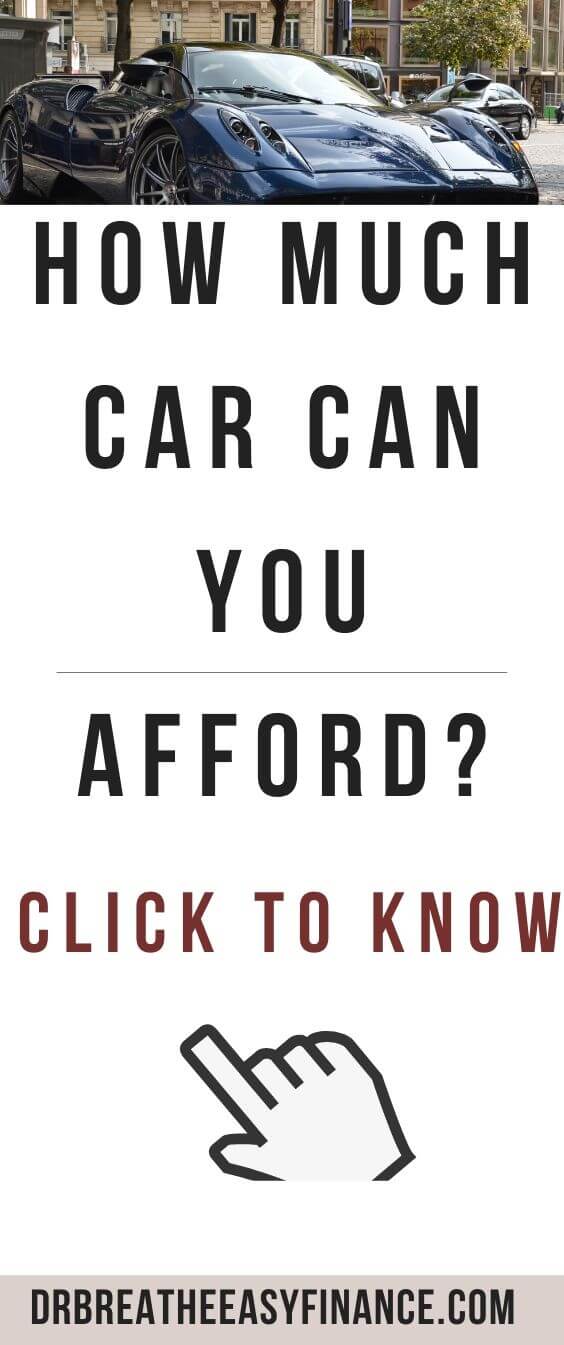Go ahead, and ask a financial expert this question, and chances are you’re bound to get quite a few answers.
Whether it’s the 10% gross income rule for monthly car payments and expenses or the 25% rule for purchasing a new vehicle, there is no one size fits all answer financial experts can agree on when it comes to how much “Car” you can afford.
Chances are, you might not be able to afford the car you truly desire, but you’re looking for affordability.
A car is designed to get you from point A to point B, and while it might be nice to do that in style, affordability is a better option. This leaves you with these two car affordability options, the last being a high spending maximum:
- Conservative: Car value is 25% or less of annual gross income
- Moderate: Car value is 35% of your annual gross income
- High: Car value is 45% of your annual gross income
So where do you start when it comes to car buying?
Table of Contents
Your salary should determine what car you can afford!
What car buying typical resembles is something similar to the example below:
- A customer looks online for a car or goes to a dealership
- The potential car buyer selects a car based on their wants, then fits financing around the purchase price
- Fitting the “Finances” typically leads to longer-term lengths to have an “Affordable” car payment without factoring in other car expenses like fuel and insurance.
According to Value Penguin in 2019, the average car loan term was 68 months!
However, within five years (60 months) a car loses on average 60% of the initial purchase value. So a $20,000 car at purchase would be worth $8,000 or less in five years – with still eight more months of payments to go!
For these reasons, this is why car buying shouldn’t be about what you want – but what you can afford!
Big-ticket purchases such as homes and cars go beyond what you can just afford monthly, because there are layers and other expenses to consider, such as taxes, insurance, fuel, and auto maintenance.
All of this leads to car buying rule number one when it comes to buying a car:
Your annual salary should determine the price of the car you can afford!
Let’s take hypothetical Jenny for example.
Jenny makes $65,000 per year before taxes, aka her gross salary. Based on the conservative, moderate, and high car affordability percentages, her car affordability would look something like this:
- Conservative Car Value = $16,250 (Car value is 25% of Jenny’s annual gross income)
- Moderate Car Value = $22,750 (Car value is 35% of Jenny’s annual gross income)
- High Car Value = $29,250 (Car value is 45% of Jenny’s annual gross income)
For Jenny, the best option would be to purchase a vehicle that leans more towards the conservative side, or at the most, the moderate value of $22,750. Purchasing a car at the “High Car Value,” or 45% of her salary would cost her $487 per month for 60 months – and that is just the monthly car payment.
By following the 25% rule, she is essentially guaranteeing herself a car payment she can afford, which is the next component of affordable car purchasing – monthly payments.
Affordable Monthly Car Payments
Most car purchases start as an idea, and end with the question, “How much can I afford monthly for a new car?”
Ideally, the best rule to follow when buying a car is the 25% gross salary rule, since it is 100% based on what you make each year. However, that doesn’t necessarily help you when it comes to your monthly car payment.
For that, it’s best to use the “10%” number from the 20-4-10 car buying rule (We will cover the entire rule here in a few).
The 10% number refers to making sure that no more than 10% of your gross monthly income goes towards your automobile costs. The standard monthly car costs include:
- Your auto payment
- Your auto insurance
- Gas
- Car maintenance
What does the 10% rule look like?
In hypothetical Jenny’s case, her $65,000 annual gross salary equates to $5,416 per month (gross). The 10% rule for Jenny would mean she has $541 per month to pay towards ALL of her car expenses each month.
That means Jenny has $541 to pay for:
- Gas,
- Insurance,
- Any maintenance and
- Her monthly car payment.
If Jenny had gone with the high car purchase from earlier – purchasing a car at 45% of her salary would cost her $487 per month in just her car payment. Thus, she would only have $54 per month for everything else.
$54 for gas is hardly doable, let alone car insurance premiums and maintenance. In this case, the high car purchase would guarantee Jenny spends more than 10% each month on her car!
Here is a side by side comparison of the 10% monthly car expense rule using the car purchase 25% rule:
| 25% Gross Income Rule | Car Expenses: | 45% Gross Income Rule |
| $270 | Monthly Payment | $487 |
| $271 | Left Over for Gas, Insurance & Maintenance | $54 |
Takeaway on the 10% rule:
Always follow the 25% gross rule when purchasing a new car and your car payment should fall in line with how much car you can afford!
As you can see in the chart above – if Jenny buys the car valued at 45% of her annual income, she would ultimately overspend each month after gas, insurance, and any maintenance. So while she might be able to “Afford” the higher valued car, after all the expenses associated with her car, she should be conservative when pricing a car.
Follow the 20-4-10 rule when buying a car!
So at this point, you understand the two most essential rules when it comes to buying cars.
- Don’t purchase a car valued at more than 25% of your annual gross income
- Make sure your monthly car expenses and payments are less than 10% of your monthly gross income.
The 20-4-10 car buying rule essentially guarantees you will be able to afford your car payment. Here is how it works:
- 20% down on your car purchase
- Don’t finance longer than four years or 48 months
- Make sure your monthly car expenses (Insurance, payment, gas, maintenance) do not exceed 10% of your monthly gross income.
In the case of Jenny, her car purchase at $16,250 would result in this following if she followed the 20-4-10 car buying rule:
| 20% Down | $3,250 |
| Loan Terms | Four Years Max |
| 10% Monthly | $541 total |
Ready to see how accurate these car-buying rules are?
- 25% of Jenny’s $65,000 is $16,250
- 10% of Jenny’s monthly income leaves her $541 per month to spend on car expenses
- With 20% down and her new car financed at 48 months, $13,000 is $270 per month.
The exact amount we accounted for in the affordable car payment section for Jenny. So if you never read up on car buying again, you would be all set. Simply make sure you use your salary to find the right valued car and be adamant that you only spend 10% of your monthly gross income on car expenses!
Now that you know the rules to buy a car you can afford, here are some other tips to help you mentally make sure you stay on target!

4 Tips to Help You Buy A Car You Can Afford
Here are four very simple tips to help with your next car purchase.
1. Set a car budget
Before you ever set foot on a car lot or hop on to a car buying website, be sure to set your budget.
In fact, go beyond just identifying your target car purchase price (25% gross) and the ideal monthly payment amount. Go ahead and set a budget for each of the following:
- Insurance (ideal premium)
- Fuel
- Maintenance
Let your budget help you decide what sort of car to get. You may want or desire a nice SUV, however, your budget might mean you need to instead go with a small sedan!
2. Don’t forget about the “Other” car expenses
The biggest car-buying error most people make is not considering all of the other car expenses that go with purchasing a new car.
Depending on where you live, fuel, personal property taxes, car maintenance, and insurance can really begin to add up. Here is a very simple rule of thumb when it comes to preparing for all the other expenses:
Double your monthly payment to account for gas, insurance, and car maintenance.
While not exact, typically, your insurance, fuel and car maintenance (budgeted monthly) should be approximate to your payment. If you want to get exact be sure to follow these steps:
- Check if your locality requires personal property taxes and how much
- Call your insurance agent and get a quote ahead of time
- Calculate how much you drive each month to estimate fuel costs
- Set aside at least $50 per month to cover maintenance
3. Do your best to avoid brand new cars.
Whatever you do, be sure to never buy brand new cars no matter how much you really want one. Ask financial author David Bach and he will say the same thing. He was once quoted for saying,
“Nothing … will waste more money than buying a new car.” – David Bach
Self-made millionaires are known for driving used cars. The infamous Sam Walton drove the same white pickup truck for all his years. None the less here is the biggest reason to avoid buying a brand new car:
New cars lose close to 20% of their initial value in the first year of owning one.
To put that in perspective, that is like investing in the stock market for $100,000 and having $80,000 at the end of the year. Most would be pretty upset!
Think of car purchases in the same manner! Always remember that a car is ultimately a depreciating liability.
4. Don’t get caught up with car envy!
No matter how much you know about buying a car that is affordable, one thing is for certain…
If you are buying your next car to impress others you will most likely go over budget in just about every area. Whether it is the premium fuel luxury cars require, the costly insurance or the higher costs to change tires and get the oil changed – impressive cars simply cost more!
A simple Google search of the most expensive cars to maintain will bring up all the popular luxury car brands. Keep in mind that it is just a car and by keeping your car expenses low – you can do other things like pay off student loans, save for retirement or purchase a home!
Something else to keep in mind when buying a car:
Have you ever heard of debt to income ratio? If you have ever bought a house, chances are you have. Either way, your debt to income ratio is simple.
How much money do you pay in monthly DEBT payments compared to the amount you make each month (Income). This number is important for buying a home. Lenders want to see most potential home buyers with a DTI of 36%, 43% max.
One of the quickest ways to mess up your debt to income ratio is to buy a car with a high monthly payment!
Affording the right car options:
There are plenty of options when it comes to buying a car you can afford, and the best two are either buying used or certified pre-owned.
Buy Certified Pre-owned
Buying a certified pre-owned is a great option for car buying. Essentially, you’re buying a brand new car. In order for a car to be considered certified pre-owned, they must go through a minimum 150 point inspection, but typically more.
Additionally, certified pre-owned cars carry factory warranty options. However, CPO cars carry a higher premium than normal used cars.
Buy Used Cars
Whether you buy certified pre-owned, used, or from a private seller, buying used is your best bet. Lemon laws, extended warranties, and car buying websites have made the process of buying used cars more fair for the consumer.
Other car buying options include buying new, which is highly discouraged due to the high markup and quicker depreciation. The last option some will be tempted to explore is leasing a car.
Don’t Lease a Car
In most cases, leasing a car is not ideal for the everyday person. For every business owner who has the ability to deduct their car lease, most consumers are tempted with the lower payment and the flashy new car.
However, leasing a car is essentially a rent to buy program with countless limitations such as milage. For the focus of this article, car affordability, leasing a car is highly discouraged in most situations.
What about car warranties?
According to a Consumer Reports study, extended car warranties are used less than 55% of the time and only 1 in 4 who purchase an extended warranty are willing to purchase another.
In fact, many respondents stated that the actual cost of getting the repairs done on their own is cheaper than the actual warranty. For example, a roadside hazard and tire warranty might cost $450, but a set of brand new tires is similar in price depending on your vehicle make.
It’s up to you and your feelings when it comes to car warranties, but here is an option to consider:
Consider saving the amount you would pay for an extended warranty and stashing the amount in your emergency savings (or starting one). This way if you need to access it for car troubles, you have the money saved!
My final word when it comes to buying an affordable car!
Back in October 2014, I went to the dealership my friend worked at to have him fix my paid off Honda Civic’s window.
Three hours later I drove off the lot in a 2014 $42,000 GMC Sierra, the most impulsive buy of my life. By December 2014 I was really feeling the heat when it came to making payments.
The $100 in fuel and $75 for insurance for my Honda quickly became $200 in fuel and close to $100 in insurance. I forgot to factor local personal property taxes at $900 every six months and my car payment was close to $450.
Needless to say at the time, I had bought a car I thought I could afford. The truck I had just bought was almost 65% of my gross annual salary. Not to mention the uptick in fuel, insurance premiums and maintenance costs.
I share this story because I ultimately made the smart financial decision and decided to trade down to a more affordable car. In my particular case, I had completely broken every single rule when it came to car buying!
- Impulse buy – check.
- 65% of my gross income – check.
- No budget for other expenses – check.
Financially I became very stressed trying to make ends meet each month. So now I always follow the 25% car value rule and I only buy cars with cash.
While it might be a stretch to buy cars in cash for many, if you follow the 10% car allowance each month you will be able to make your monthly car payments with ease!
Cheers to your new (used) car and not putting yourself in a bad financial situation when it comes to car buying!
This article originally appeared on The Money Mix and has been republished with permission.

Josh @Money Life Wax
Josh runs the blog Money Life Wax. He says they want to provide the how-to mindset, and resources for others to learn how to create both financial options and life of everlasting happiness; to help make a difference in the world, even if it is a small difference. The goal of their content is to motivate and incite action in the reader’s lives so that they can create a better financial situation for themselves. This typically starts with teaching how to pay off debt and become more knowledgeable on the subject of money. A healthier financial situation means a healthier home, family, relationship, community, and a lot more happiness!








Leave a Reply